The Regenerative Turbine Pump Market is estimated to be valued at USD 271.1 million in 2025 and is projected to reach USD 548.5 million by 2035, registering a compound annual growth rate (CAGR) of 7.3% over the forecast period. Analysis of price evolution and average selling price (ASP) trends indicates a steady yet gradual increase in market valuations, which is consistent with incremental enhancements in pump efficiency, material quality, and performance capabilities.
From 2025 onwards, annual market value increments of approximately USD 20–30 million suggest that manufacturers are able to maintain moderate price growth while introducing technologically advanced pump variants designed to meet industrial and municipal fluid-handling demands. The gradual rise in ASP is influenced by factors such as adoption of corrosion-resistant materials, enhanced hydraulic designs, and integration of smart monitoring components.
These enhancements, while raising unit costs, are also positioned to justify higher pricing through improved operational efficiency, energy savings, and lower maintenance requirements. Furthermore, competitive dynamics and regional demand fluctuations play a role in moderating price growth, as suppliers balance cost pressures with market penetration objectives.
By 2035, the ASP trajectory is projected to stabilize as the market matures, with incremental gains reflecting continued adoption of energy-efficient and high-performance pump models. Overall, the price evolution demonstrates a deliberate and sustainable increase, supporting market expansion from USD 271.1 million in 2025 to USD 548.5 million in 2035 under a 7.3% CAGR, while aligning unit prices with technological and value-added improvements.
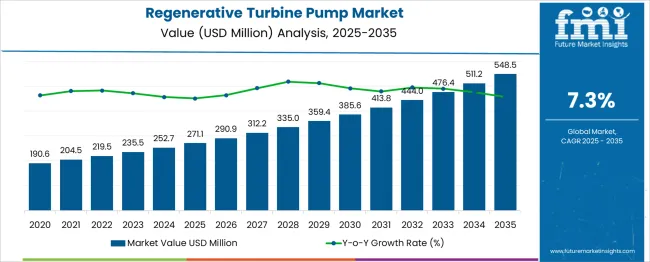
| Metric | Value |
|---|---|
| Regenerative Turbine Pump Market Estimated Value in (2025 E) | USD 271.1 million |
| Regenerative Turbine Pump Market Forecast Value in (2035 F) | USD 548.5 million |
| Forecast CAGR (2025 to 2035) | 7.3% |
The increasing emphasis on equipment that can sustain operation under varying inlet conditions and handle low NPSH scenarios has elevated the preference for regenerative turbine technologies.
These pumps are particularly gaining traction in applications such as boiler feed, cooling systems, refrigeration, chemical dosing, and fuel transfer due to their unique capability to combine the advantages of both centrifugal and positive displacement pumps. The rising demand for industrial automation and the need for precise fluid handling in compact spaces are driving their integration into modern process lines.
Moreover, ongoing advancements in energy-efficient motor technologies and precision-engineered pump designs are enhancing performance outcomes. As infrastructure modernization and fluid system optimization gain momentum across sectors such as HVAC, food processing, and pharmaceuticals, regenerative turbine pumps are poised to witness increased deployment, supported by their service flexibility and maintenance-friendly construction.
The regenerative turbine pump market is segmented by product, priming, capacity application, and geographic regions. By product, the regenerative turbine pump market is divided into Single-Stage and Multi-Stage. In terms of priming, the regenerative turbine pump market is classified into Self-Priming and Non-Self-Priming. Based on capacity of the regenerative turbine pump market is segmented into 10 GPM - 30 GPM, 10 GPM, 30 GPM - 60 GPM> 60 GPM. The regenerative turbine pump market is segmented into water and wastewater, Agriculture, Chemical Plants, building and construction, Industrial, oil and gas, and Others. Regionally, the regenerative turbine pump industry is classified into North America, Latin America, Western Europe, Eastern Europe, Balkan & Baltic Countries, Russia & Belarus, Central Asia, East Asia, South Asia & Pacific, and the Middle East & Africa.
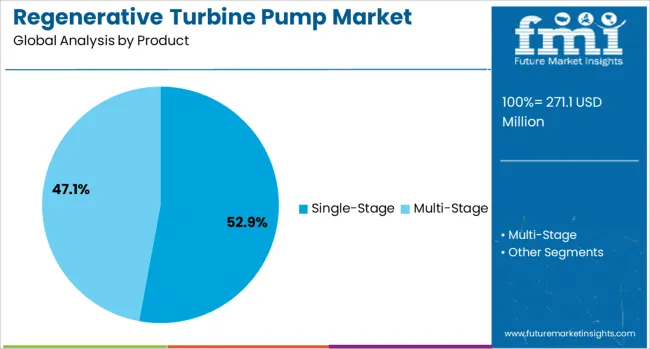
The single stage product segment is projected to account for 52.9% of the total revenue share in the regenerative turbine pump market in 2025, reflecting its position as the most preferred product configuration. This dominance is being driven by the compact design, lower manufacturing complexity, and reduced maintenance associated with single stage systems. These pumps have been widely adopted in applications requiring stable flow at high heads without the need for multistage assemblies.
Their cost-effectiveness, minimal footprint, and reliable performance under fluctuating inlet pressures have contributed to their broad acceptance across industries. Additionally, single stage designs allow easier integration into standardized machinery and piping networks, reducing installation overheads and system downtime.
The increasing demand for simplified, yet precise fluid transport systems in industries such as beverage processing, water treatment, and semiconductor manufacturing has further supported their growth. As operational efficiency and reliability remain critical to fluid system performance, single stage regenerative turbine pumps continue to be favored for both retrofits and new installations.
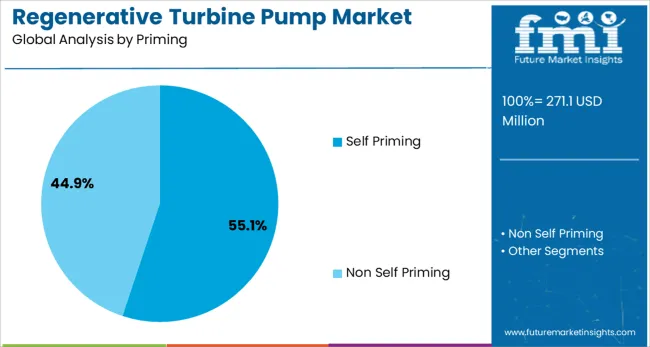
The self priming segment is expected to capture 55.1% of the regenerative turbine pump market's revenue share in 2025, making it the leading priming category. The segment's growth has been influenced by the need for pumps that can operate effectively even with intermittent or negative suction head conditions. Self priming functionality eliminates the need for additional external priming devices, simplifying system architecture and reducing startup time.
This has made such pumps particularly attractive in remote or automated operations where manual priming is not feasible. Their ability to maintain suction lift and restart automatically after air entrapment or fluid depletion has enhanced operational safety and reliability in applications like chemical transfer, condensate removal, and fuel handling.
As industrial users focus on reducing operational intervention and maximizing uptime, the adoption of self priming regenerative turbine pumps has accelerated. Their design also supports compliance with environmental regulations by minimizing leakage and vapor emissions during operation and restart cycles.
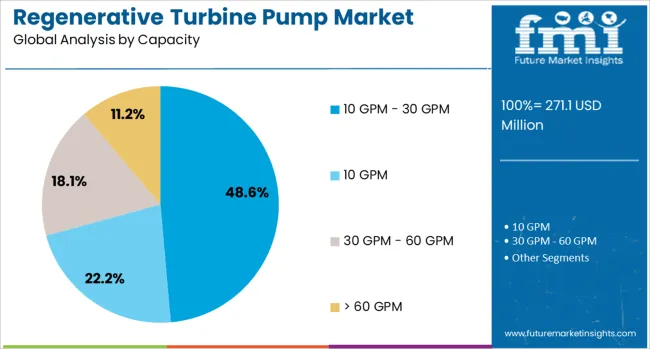
The capacity range of 10 GPM to 30 GPM is projected to hold 48.6% of the regenerative turbine pump market's revenue share in 2025, highlighting its relevance in low to moderate flow applications. This segment has gained traction due to its alignment with fluid handling needs in industries where precise dosing, recirculation, or metering of liquids is essential.
Pumps within this capacity range have been extensively used in sectors such as chemical processing, laboratory systems, and light fuel transfer where consistent performance is required under limited flow. Their balanced profile of efficiency, noise control, and mechanical stability has positioned them as optimal solutions for compact and energy-sensitive environments.
The increasing trend of process downsizing and modular plant design has further supported the demand for pumps within this capacity class. By offering reliable output in critical but lower-volume operations, the 10 GPM to 30 GPM range has become a preferred choice for maintaining both performance consistency and system economy.
The market has been expanding due to the increasing need for efficient fluid handling in industrial, municipal, and chemical applications. These pumps have been widely utilized for transferring clean, low-viscosity liquids with high discharge pressures and precise flow control. Market growth has been supported by advancements in pump design, materials, and sealing technologies that enhance durability and performance. Rising demand in water treatment, oil and gas, and chemical processing industries, coupled with energy-efficient operation, has further driven the adoption of regenerative turbine pumps globally.
The industrial and chemical sectors have been major drivers of the regenerative turbine pump market due to the need for reliable fluid transfer and precise pressure control. Pumps have been used for chemical dosing, cooling water circulation, boiler feed, and high-pressure cleaning operations. Their ability to handle clean, low-viscosity liquids with minimal pulsation and consistent discharge pressure has made them preferred solutions for chemical plants, refineries, and process industries. Maintenance efficiency and long service life have increased operational reliability, reducing downtime and associated costs. In addition, the growth of industrial facilities and expansion of process industries in Asia-Pacific and Europe have created significant demand. The need for corrosion-resistant materials, advanced sealing, and compact pump designs has further reinforced the use of regenerative turbine pumps in diverse industrial applications worldwide.
Technological improvements in regenerative turbine pumps have enhanced efficiency, durability, and operational flexibility. Modern pumps have been designed with precision impellers, wear-resistant materials, and advanced shaft sealing mechanisms to reduce energy consumption and extend service life. Hydraulic designs have been optimized for high-pressure operation, low noise levels, and minimal vibration. Integration with digital monitoring, flow sensors, and automation systems has enabled real-time performance tracking and predictive maintenance, improving reliability and reducing operational risks. The modular and compact designs have allowed easy installation in confined spaces and complex process setups. These advancements have made regenerative turbine pumps more suitable for high-pressure and high-precision applications across industrial, municipal, and chemical sectors, supporting their adoption in both new installations and retrofitting projects.
Municipalities and water treatment facilities have increasingly utilized regenerative turbine pumps to manage clean water distribution, pressure boosting, and irrigation systems. The ability to handle high pressures with controlled flow has been critical in maintaining consistent water supply across distribution networks. Pumps have also been deployed in wastewater treatment plants for dosing chemicals and recirculation purposes. The operational reliability, ease of maintenance, and energy-efficient performance of regenerative turbine pumps have made them suitable for large-scale municipal systems where uptime is crucial. Furthermore, infrastructure modernization and expansion in emerging economies have encouraged investment in advanced pumping solutions. By providing stable hydraulic performance and supporting automated control systems, regenerative turbine pumps have strengthened their position as essential components in municipal water management and treatment applications globally.
The focus on energy efficiency and sustainability has created new growth opportunities for regenerative turbine pumps. Energy-optimized hydraulic designs, high-efficiency motors, and variable frequency drive integration have reduced power consumption and operational costs. Environmentally friendly materials and low-leakage sealing technologies have minimized fluid losses and environmental impact. The growing adoption of renewable energy facilities, industrial cooling systems, and water recycling plants has expanded demand for efficient, reliable pumps capable of high-pressure operation. The government incentives and regulations promoting energy-efficient equipment have encouraged the replacement of conventional pumps with regenerative turbine solutions. As industrial and municipal operators prioritize sustainability, energy savings, and operational resilience, regenerative turbine pumps are expected to see continued adoption and expanded market penetration globally.
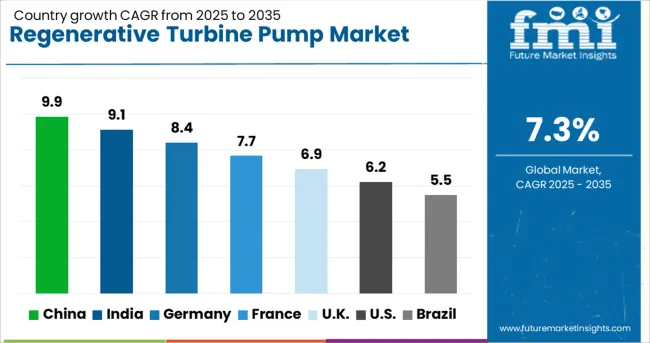
| Country | CAGR |
|---|---|
| China | 9.9% |
| India | 9.1% |
| Germany | 8.4% |
| France | 7.7% |
| UK | 6.9% |
| USA | 6.2% |
| Brazil | 5.5% |
The market is expected to grow at a CAGR of 7.3% between 2025 and 2035, supported by rising industrial fluid handling requirements, advancements in pump efficiency, and increasing adoption in water treatment and chemical processing. China leads with a 9.9% CAGR, driven by expanding industrial and municipal infrastructure projects. India follows at 9.1%, fueled by rapid industrialization and energy sector developments. Germany, at 8.4%, benefits from high-quality manufacturing standards and advanced engineering applications. The UK, with a 6.9% CAGR, sees growth due to modernization of water and wastewater management systems. The USA, at 6.2%, experiences steady demand from industrial automation and maintenance of existing pumping infrastructure. This report includes insights on 40+ countries; the top markets are shown here for reference.
The industry in China is projected to expand at a CAGR of 9.9% from 2025 to 2035, fueled by increasing demand in water treatment, industrial process, and chemical sectors. Manufacturers are integrating energy-efficient pump designs with high suction capabilities to support industrial and municipal applications. Strategic collaborations between domestic pump producers and international engineering firms are driving technological advancements. Adoption of modular and compact units in commercial and utility applications is rising. Focus on low-maintenance solutions and long-life components is strengthening market traction. Regional industrial hubs are witnessing high demand for precise flow control and reliable pumping solutions, further supporting growth.
The Indian market is anticipated to grow at a CAGR of 9.1%, supported by industrial modernization and expansion of chemical and power generation facilities. Local manufacturers are offering compact and high-efficiency pumps tailored for Indian industrial operations. Installation of regenerative pumps in municipal water supply systems is accelerating. Focus on low energy consumption and extended operational life is driving adoption. Demand for pumps with precise flow control is increasing in industrial process applications. Strategic partnerships with global engineering firms are fostering technology transfer and enhanced reliability.
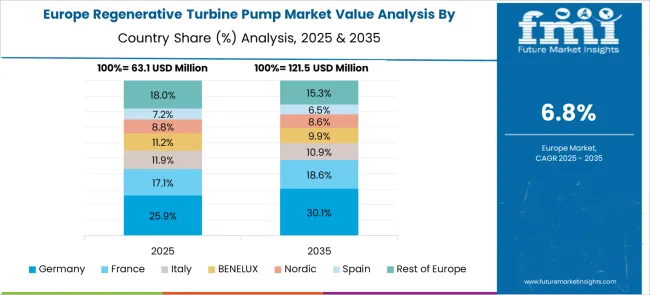
Germany is expected to register a CAGR of 8.4%, driven by investments in industrial automation, chemical processing, and energy sectors. Demand is focused on pumps that combine high efficiency with precision control. German manufacturers are integrating smart monitoring and predictive maintenance features. Environmental compliance is influencing adoption of eco-friendly hydraulic designs. Growth in renewable energy and utility projects is supporting long-term demand. Adoption of modular pump units for chemical and water treatment applications is increasing.
The United Kingdom is projected to grow at a CAGR of 6.9%, supported by infrastructure upgrades and modernization of municipal water systems. Energy-efficient pump designs with automated monitoring are gaining traction in industrial and commercial applications. Manufacturers are focusing on durable and low-maintenance units suitable for harsh operating conditions. Adoption of regenerative pumps in wastewater treatment and chemical processing is increasing. Partnerships between domestic suppliers and international technology providers are enhancing service reliability and installation efficiency.
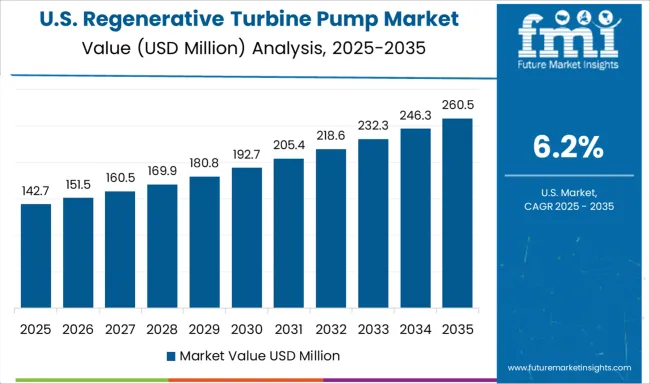
The United States market is forecast to expand at a CAGR of 6.2%, driven by replacement of aging pump infrastructure and increased industrial capacity. Demand is focused on high-efficiency and durable regenerative pumps for municipal and industrial applications. Manufacturers are incorporating smart diagnostics and IoT monitoring to optimize performance. Adoption is particularly high in chemical plants, power generation facilities, and water treatment projects. Energy consumption and lifecycle cost considerations are influencing purchasing decisions. Strategic alliances with technology providers are supporting faster deployment and maintenance.
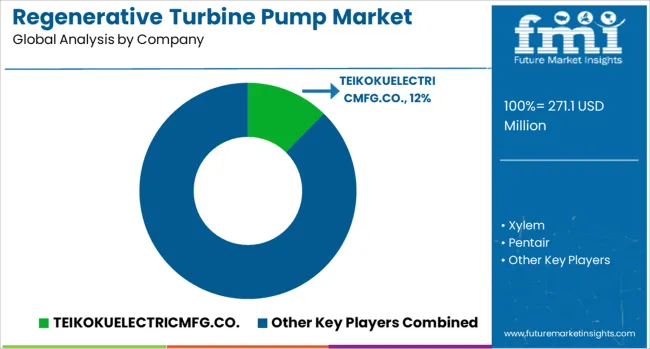
Pricing strategies in the market are largely value-based, reflecting energy efficiency, material specialization, and application-specific design rather than simple cost competition. High-end players employ project-based pricing for industrial and municipal projects, incorporating engineering consultation, performance testing, and lifecycle service contracts. Mid-tier and regional players compete with standardized pump models at competitive cost, focusing on OEM partnerships and small- to medium-scale industrial installations. Commercial strategies are further differentiated through turnkey solutions, maintenance contracts, and aftermarket support, ensuring long-term client engagement while reinforcing brand credibility in critical infrastructure applications.
The regenerative turbine pump market is dominated by key players such as Sulzer, KSB, Flowserve, Grundfos, and Iwaki, each leveraging distinct capabilities to secure a competitive position. Sulzer capitalizes on modular design architecture and high-efficiency impellers to offer pumps that can handle high-pressure, low-flow applications with minimal energy loss, particularly in chemical processing and municipal water networks. KSB emphasizes precision engineering and corrosion-resistant materials, enabling reliable operation in aggressive media and high-temperature conditions, which creates a performance-led differentiation that supports premium pricing. Flowserve leverages its global service networks and retrofit expertise, targeting large industrial and oil & gas installations, while Grundfos differentiates itself through digitally integrated solutions and variable-speed drives, enhancing operational efficiency and predictive maintenance capabilities.
| Item | Value |
|---|---|
| Quantitative Units | USD 271.1 Million |
| Product | Single-Stage and Multi-Stage |
| Priming | Self Priming and Non Self Priming |
| Capacity | 10 GPM - 30 GPM, 10 GPM, 30 GPM - 60 GPM, and > 60 GPM |
| Application | Water & Wastewater, Agriculture, Chemical Plants, Building & Construction, Industrial, Oil & Gas, and Others |
| Regions Covered | North America, Europe, Asia-Pacific, Latin America, Middle East & Africa |
| Country Covered | United States, Canada, Germany, France, United Kingdom, China, Japan, India, Brazil, South Africa |
| Key Companies Profiled | TEIKOKUELECTRICMFG.CO., Xylem, Pentair, ITTINC., PSG, VikingPump, MTHPumps, IwakiAmerica, RothPumpCo., SPECKPumpenVerkaufsgesellschaftGmbH, NikuniCorpration, MagnatexPumps, CranePumps&Systems, Corken-AdvancedFlowSolutions, and SterlingPumps |
| Additional Attributes | Dollar sales by pump type and application sector, demand dynamics across chemical processing, water treatment, and industrial manufacturing, regional trends in adoption across North America, Europe, and Asia-Pacific, innovation in high-efficiency impeller designs, corrosion-resistant materials, and energy-optimized operation, environmental impact of energy consumption, fluid leakage, and maintenance waste, and emerging use cases in precision chemical dosing, high-viscosity fluid transfer, and sustainable industrial pumping solutions. |
The global regenerative turbine pump market is estimated to be valued at USD 271.1 million in 2025.
The market size for the regenerative turbine pump market is projected to reach USD 548.5 million by 2035.
The regenerative turbine pump market is expected to grow at a 7.3% CAGR between 2025 and 2035.
The key product types in regenerative turbine pump market are single-stage and multi-stage.
In terms of priming, self priming segment to command 55.1% share in the regenerative turbine pump market in 2025.






Our Research Products

The "Full Research Suite" delivers actionable market intel, deep dives on markets or technologies, so clients act faster, cut risk, and unlock growth.

The Leaderboard benchmarks and ranks top vendors, classifying them as Established Leaders, Leading Challengers, or Disruptors & Challengers.

Locates where complements amplify value and substitutes erode it, forecasting net impact by horizon

We deliver granular, decision-grade intel: market sizing, 5-year forecasts, pricing, adoption, usage, revenue, and operational KPIs—plus competitor tracking, regulation, and value chains—across 60 countries broadly.

Spot the shifts before they hit your P&L. We track inflection points, adoption curves, pricing moves, and ecosystem plays to show where demand is heading, why it is changing, and what to do next across high-growth markets and disruptive tech

Real-time reads of user behavior. We track shifting priorities, perceptions of today’s and next-gen services, and provider experience, then pace how fast tech moves from trial to adoption, blending buyer, consumer, and channel inputs with social signals (#WhySwitch, #UX).

Partner with our analyst team to build a custom report designed around your business priorities. From analysing market trends to assessing competitors or crafting bespoke datasets, we tailor insights to your needs.
Supplier Intelligence
Discovery & Profiling
Capacity & Footprint
Performance & Risk
Compliance & Governance
Commercial Readiness
Who Supplies Whom
Scorecards & Shortlists
Playbooks & Docs
Category Intelligence
Definition & Scope
Demand & Use Cases
Cost Drivers
Market Structure
Supply Chain Map
Trade & Policy
Operating Norms
Deliverables
Buyer Intelligence
Account Basics
Spend & Scope
Procurement Model
Vendor Requirements
Terms & Policies
Entry Strategy
Pain Points & Triggers
Outputs
Pricing Analysis
Benchmarks
Trends
Should-Cost
Indexation
Landed Cost
Commercial Terms
Deliverables
Brand Analysis
Positioning & Value Prop
Share & Presence
Customer Evidence
Go-to-Market
Digital & Reputation
Compliance & Trust
KPIs & Gaps
Outputs
Full Research Suite comprises of:
Market outlook & trends analysis
Interviews & case studies
Strategic recommendations
Vendor profiles & capabilities analysis
5-year forecasts
8 regions and 60+ country-level data splits
Market segment data splits
12 months of continuous data updates
DELIVERED AS:
PDF EXCEL ONLINE
Vertical Turbine Pump Market Size and Share Forecast Outlook 2025 to 2035
North America Vertical Turbine Pump Market Analysis & Forecast by Head, Material Type, Stages, Power Rating, End-use, and Region Through 2035
Regenerative Biologic Injectables Market Size and Share Forecast and Outlook 2025 to 2035
Regenerative Artificial Skin Market Size and Share Forecast Outlook 2025 to 2035
Pump Jack Market Forecast Outlook 2025 to 2035
Pump and Dispenser Market Size and Share Forecast Outlook 2025 to 2035
Turbine Oils Market Size and Share Forecast Outlook 2025 to 2035
Regenerative Agriculture Market Size and Share Forecast Outlook 2025 to 2035
Pump Testers Market Size and Share Forecast Outlook 2025 to 2035
Pumpjacks Market Size and Share Forecast Outlook 2025 to 2035
Pumps Market Size and Share Forecast Outlook 2025 to 2035
Pumpkin Seed Protein Market Size and Share Forecast Outlook 2025 to 2035
Regenerative Braking System Market Size and Share Forecast Outlook 2025 to 2035
Turbine Blade Material Market Size and Share Forecast Outlook 2025 to 2035
Pumped Hydro Storage Market Size and Share Forecast Outlook 2025 to 2035
Pump Tubes Market Size and Share Forecast Outlook 2025 to 2035
Pumpkin Pie Spices Market Analysis - Size, Share, and Forecast 2025 to 2035
Regenerative Medicine Market Growth – Trends & Forecast 2025 to 2035
Pumps and Trigger Spray Market Trends - Growth & Forecast 2025 to 2035
Pump Condiment Dispensers Market - Effortless Portion Control 2025 to 2035

Thank you!
You will receive an email from our Business Development Manager. Please be sure to check your SPAM/JUNK folder too.
Chat With
MaRIA